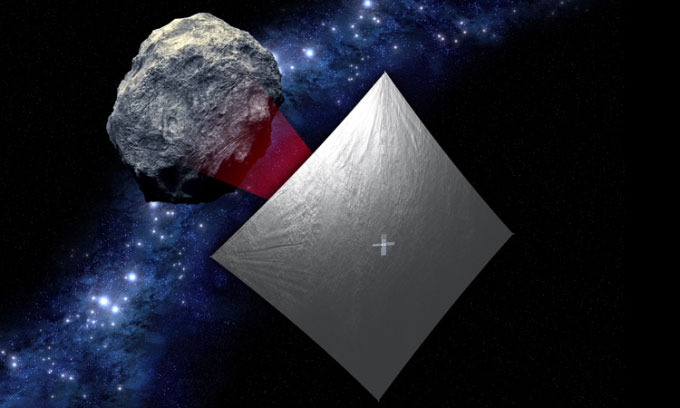NASA is about to launch the smallest asteroid research ship
NASA on January 20 announced that, during the launch of Artemis I, another spacecraft called the Near-Earth Asteroid Reconnaissance (NEA Scout) spacecraft will also fly into space. Artemis I was an unmanned mission to test the SLS super rocket and Orion spacecraft, paving the way for a program to return humans to the Moon.

Illustration of the NEA Scout with its sails wide open as it flies over the target asteroid.
The NEA Scout is a compact cubesat. The NEA Scout's Sun Sail is made of super-thin plastic coated aluminum and will be about 86 square meters when unfolded. Meanwhile, the cubesat is only as big as a shoe box.
NEA Scout's target is 2020 GE, an asteroid estimated to be smaller than a bus with a diameter of less than 18 meters. According to NASA, this will be the smallest asteroid ever studied by the spacecraft.
The NEA Scout will fly to 2020 GE by opening its Solar sails and harnessing solar radiation for propulsion. This is NASA's first deep space mission deployed this way. Solar sail technology is still relatively new. Slightly different from the name, the spacecraft will rely on photons from the Sun instead of the wind. The Planetary Society tested the technology with the 2019 LightSail 2 launch.
NASA plans to study GE 2020 and find out if it's a single solid mass or a collection of compacted rock formations. "While large asteroids are of greatest concern in terms of planetary defense, objects like 2020 GE are much more common and potentially hazardous to Earth, despite their small size. ", said Julie Castillo-Rogez, scientist on the NEA Scout mission.
Artemis I is expected to launch this year, possibly as early as March or April. If all goes well, NEA Scout will reach the target asteroid by the end of 2023.
- NASA sends a spaceship to carry soil
- NASA is about to launch Discovery ship to rebuild ISS
- NASA is about to crash a $ 330 million spacecraft into an asteroid
- Plan to launch spaceship chasing asteroid
- Video: NASA ship borrowed Earth's force to soar to the asteroid
- NASA studies spacecraft with an asteroid explorer
- NEOWISE detects new asteroids
- NASA consecutively delayed the release of two radiation probes
- NASA builds asteroid-hunting space telescope
- Magnetic anomalies' asteroids cannot reach
- American launch ship tracking the sun
- Japanese explorer ship collects rock samples from Ryugu asteroid
 Van Allen's belt and evidence that the Apollo 11 mission to the Moon was myth
Van Allen's belt and evidence that the Apollo 11 mission to the Moon was myth The levels of civilization in the universe (Kardashev scale)
The levels of civilization in the universe (Kardashev scale) Today Mars, the sun and the Earth are aligned
Today Mars, the sun and the Earth are aligned The Amazon owner announced a secret plan to build a space base for thousands of people
The Amazon owner announced a secret plan to build a space base for thousands of people Scientists say: Eating crayfish is the best way to eradicate this terrifying virgin animal
Scientists say: Eating crayfish is the best way to eradicate this terrifying virgin animal  Top 11 foods and drinks to help ease Covid-19 symptoms
Top 11 foods and drinks to help ease Covid-19 symptoms  Climate change could create more 'sky rivers' in East Asia
Climate change could create more 'sky rivers' in East Asia  'Artificial forest' sucks 1,000 tons of CO2 per day
'Artificial forest' sucks 1,000 tons of CO2 per day  Mistaking plastic bottles for food, stupid cobra almost killed himself
Mistaking plastic bottles for food, stupid cobra almost killed himself  Inside the world's largest body freezing facility waiting for the day of resurrection
Inside the world's largest body freezing facility waiting for the day of resurrection 